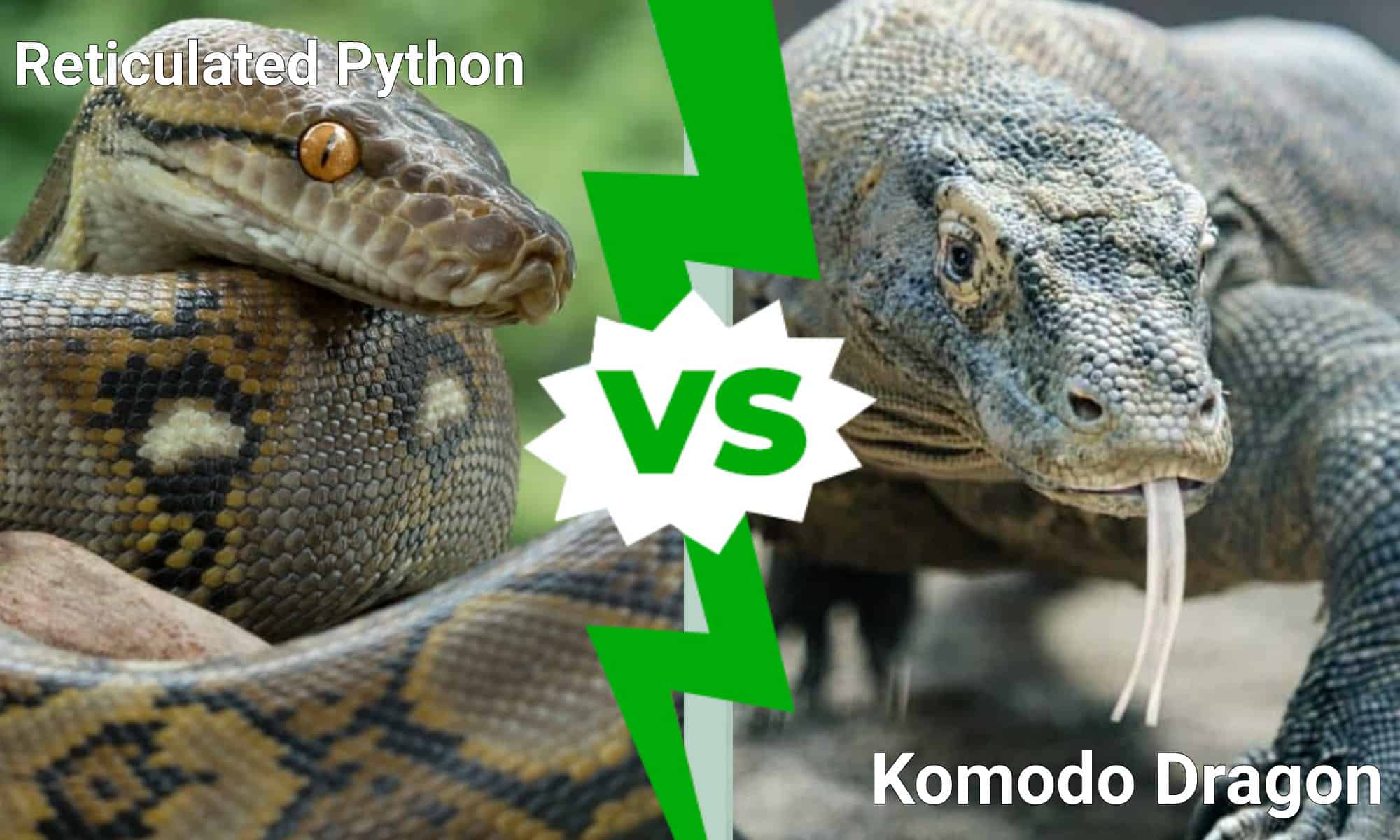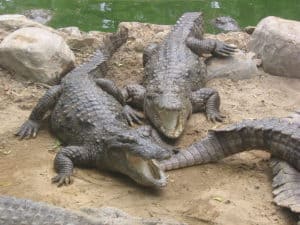Introduction
Reticulated pythons and Komodo dragons are two of the most formidable creatures on Earth. Both species can overcome prey larger than themselves and can kill humans. Furthermore, they exist within the same range throughout Southeast Asia. Thus, it is not unlikely that the two might encounter each other and engage in a fight. While the reticulated python has a strong body that constricts its prey, the venomous Komodo dragon surely poses a threat. Discover which animal wins in a fight and find out how they conquer prey.
Background on the Reticulated Python
The reticulated python ranks as one of the largest snakes on Earth. Both the reticulated python and the green anaconda are the two largest snake species. While the anaconda is more muscular and bulkier than the reticulated python, the python attains greater lengths. In fact, reticulated pythons can measure greater than 20 to 25 feet long! The python is also extremely heavy, weighing between as little as two pounds to over 170 pounds. The largest reticulated python ever recorded measured approximately 28.5 feet long and weighed around 320 pounds.
The reticulated python is native to South and Southeast Asia, especially near countries like India and surrounding islands. The snake is also non-venomous, meaning it will not inject venom into prey. The coloration, markings, and size of reticulated pythons may vary, according to location. The coloration of the snake changes because it must match its surrounding environment. By camouflaging in its natural habitat, the reticulated python can avoid predation.
Some colors most frequently seen on the reticulated python include black, tan, white, gold, green, and more. While some individuals in this species may have a color and pattern that is muted, others have markings that are highly colorful and make them stand out. Furthermore, some of these individuals have scales that appear iridescent. This feature derives from nanostructures within reticulated python scales called iridophores. Iridophores refract light and cause the python’s scales to appear shiny or rainbow-colored.
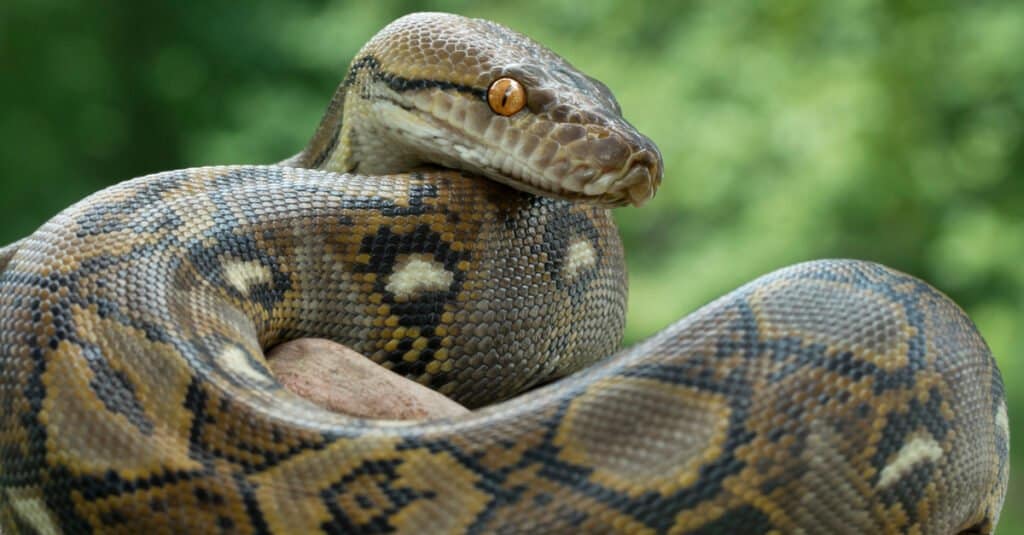
The reticulated python may grow longer than 28.5 feet!
©Mark_Kostich/Shutterstock.com
Reticulated Python Lifestyle
Reticulated pythons do not travel nor live with groups. Rather, they are solitary and move alone. Furthermore, the species is most active at night. Juvenile reticulated pythons can be encountered both on the ground and in the treetops. On the other hand, adults of this species primarily slither along the ground. While these snakes do not move fast along the ground, they are highly adept swimmers. This snake often waits in or near bodies of water to catch prey. When prey arrives at a stream or river to drink, the reticulated python can attack the prey at a second’s notice.
The diet of the species includes several mammals and some birds. Some mammals that the reticulated python devours are rats, wild hogs, chickens, and small primates. They may also snatch up and swallow fish from water sources. Overall, though, the reticulated python is likely to eat anything it can get its scales on. The snake’s diet is extremely broad, allowing the species a diverse assortment of potential prey.
Dangers of Reticulated Pythons
Although reticulated pythons are non-venomous, they still pose an incredible danger to prey and humans. These snakes suffocate prey by wrapping around its body and constricting it. Reticulated pythons typically bite a victim before suffocating it. From there, the python will constrict the prey. Constriction blocks blood flow throughout the body, blocks airways, and reduces the expansion of the chest during respiration. As this happens, the victim loses air, suffocates, and eventually dies. The constriction force of a reticulated python measures approximately 14 PSI.
Reticulated pythons are a defensive species. These snakes do not hunt for humans, but they can be dangerous. When reticulated pythons feel threatened by humans, they may strike a human. The snake will bite and then constrict a human. In addition, the reticulated python can swallow a human whole. The lower jaw of this snake can expand and come apart because it is not fully attached to the skull. The movement of the lower jaw opens the mouth of the reticulated python to great sizes. When a reticulated python swallows a victim larger than itself, it will gradually swallow it little by little until the victim remains entirely inside the snake’s stomach. This action takes around an hour to complete.
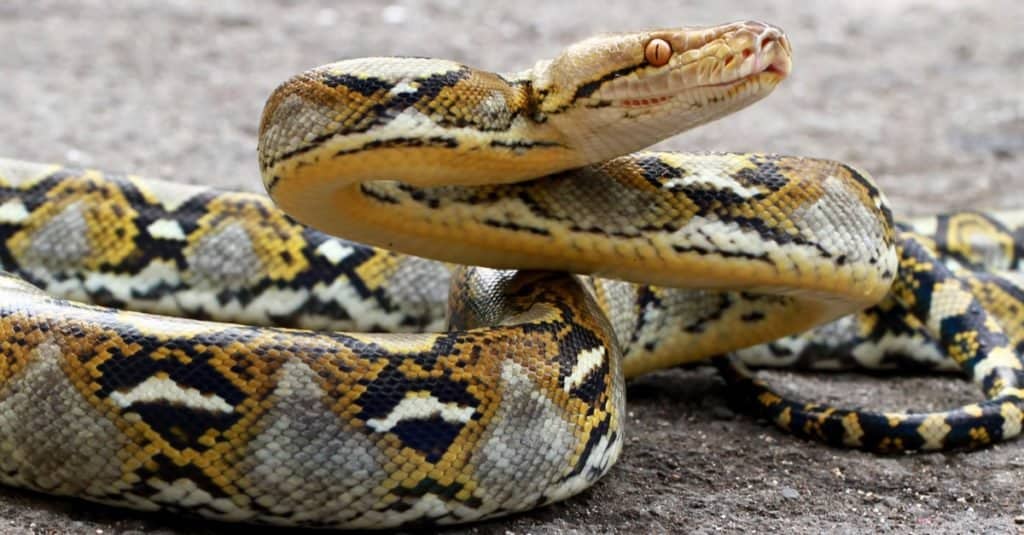
Reticulated pythons are highly defensive snakes that bite, constrict, and suffocate prey.
©Opayaza12/Shutterstock.com
Background on the Komodo Dragon
The Komodo dragon is the largest existing lizard species on Earth and one of the most fearsome. The species is native to Komodo Island and some islands surrounding the country of Indonesia. The lizard remains one of the most fascinating features of Southeast Asia, which has attracted many tourists to its natural habitat. While tourism often threatens animal species, tourism on Komodo Island has increased conservation efforts for Komodo dragons, as they are considered an endangered species.
Komodo dragons attain a maximum length of 10 feet and may weigh up to 300 pounds. The coloration of the species may be black, gray, or green, and the bodies may include yellow, brown, or white patches. One interesting fact about the Komodo dragon is that females do not always require a male mate to give birth. While most offspring are a result of mating between a male and female Komodo dragon, parthenogenesis is a process in which females can grow a gamete without the help of a male mate. The process is common to many invertebrates, such as ants and wasps. However, parthenogenesis is not common to vertebrates, which makes the Komodo dragon unique in this ability.
Komodo dragons are primarily considered scavengers, feeding on the bodies of animal carcasses. However, the species will also stalk and kill some prey, including pigs, cattle, and deer. Furthermore, these lizards have cannibalistic tendencies, often killing members of their own species. Larger Komodo dragons typically attack smaller Komodo dragons, but even some large adults are at risk of being cannibalized.
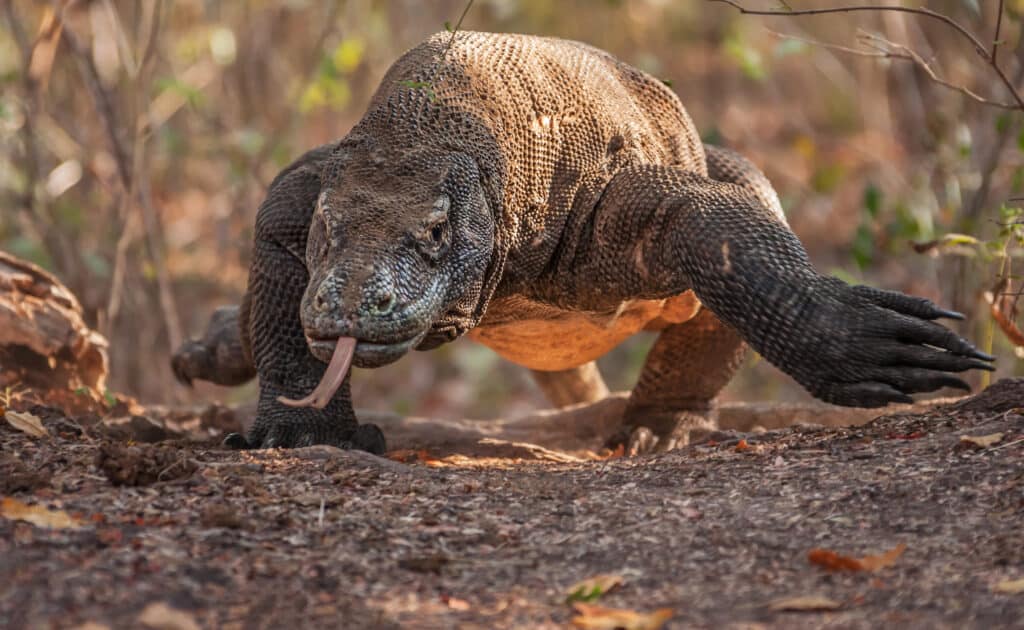
Komodo dragons are an endangered species that require conservation efforts.
©iStock.com/kiwisoul
Komodo Dragon Conservation
Most estimate the Komodo dragon population throughout Komodo Island and surrounding islands to number 1,400 individuals. The population remains stable today, but many organizations are concerned about a future decline in Komodo dragon population numbers. In 1996, the International Union for Conservation of Nature established the Komodo dragon as a vulnerable species. While tourism has increased the availability of resources that protect Komodo dragon populations, the animal is now endangered.
The IUCN maintains the Komodo dragons are safe from hunting and human interference, but climate change remains the biggest threat to the species. By 2040, experts estimate that between 30% and 70% of Komodo dragon habitat will be lost to rising sea levels. Increased sea levels will narrow the Komodo dragon’s distribution, causing greater competition among the species and decreasing population numbers.
Many conservation efforts have been made, attempting to increase the population numbers of the species and protect its natural habitat. For example, Komodo National Park is the primary location and protector of the species. The park includes various habitats and landscapes, including savanna, beaches, coral reefs, and some vegetation. Other organizations, like the Komodo Survival Program, work to spread awareness about Komodo dragon endangerment and try to educate people across the globe about the importance of the species. While conservation organizations and governments have made several efforts to protect the Komodo dragon, climate change may disrupt the road to conservation and significantly reduce population numbers regardless of these efforts.
Dangers of Komodo Dragons
While Komodo dragons do not have a strong bite force, measuring between 500 and 600 PSI, they are venomous and aggressive. The Komodo dragon has extremely sharp teeth, which are also curved. The shape of these teeth allows the creature to hook onto prey through a strong bite. The animal also has long, sharp claws that can easily rip apart the flesh of any victim. When a Komodo dragon bites down on prey, the animal will use its neck to shake the prey with intense ferocity. As this happens, the flesh and muscle of the prey are damaged, which results in incredible blood loss and sends the prey into a state of shock.
In addition, the bite of a Komodo dragon releases bacteria into a victim’s wound, causing infection and potentially resulting in sepsis. Sepsis occurs when an untreated wound becomes inflected and spreads to other areas of the body. Symptoms of the disease include extreme pain, fever, confusion, increased heart rate, and shortness of breath.
Furthermore, the venom of the Komodo dragon is extremely harmful. This venom can block the blood from clotting in prey, resulting in more blood loss and a state of shock. While some larger animals may escape a Komodo dragon attack, the venom and bacteria lodged in the wounds will have already begun their work. Thus, larger victims are likely to die after escaping an attack due to the gradual influence of infection and venom on the body.
Finally, Komodo dragons are dangerous to human life. The species has the potential to overpower animals larger than itself, such as water buffalo. Thus, a Komodo dragon attack on a human could result in fatality. In fact, there are records that indicate a few instances in which a Komodo dragon has attacked a human. While these instances are rare and unlikely, they do happen. These attacks can occur both in the wild or in captivity, such as in zoos. For example, Komodo National Park reported 24 Komodo dragon attacks on humans and five fatalities within a period of nearly 40 years.
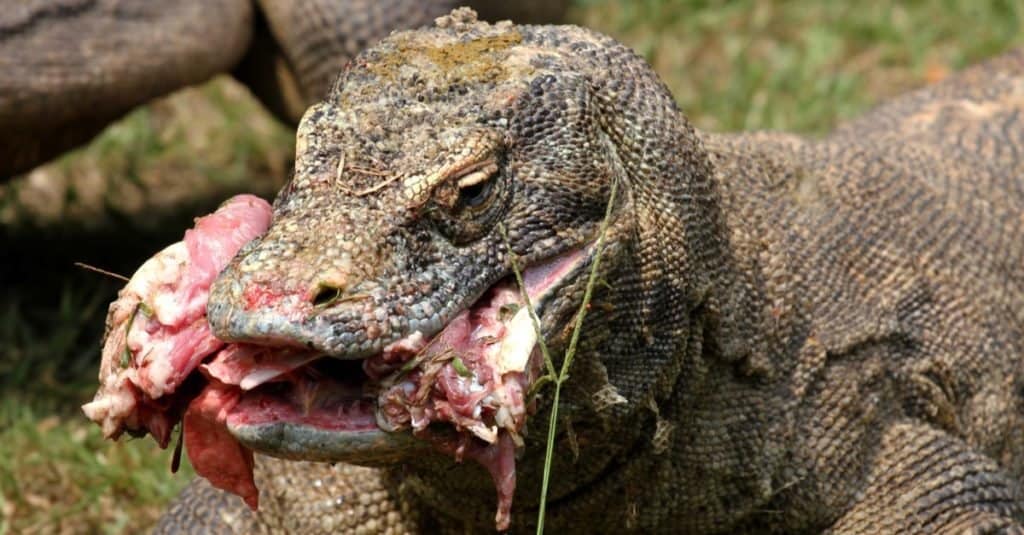
Komodo dragons rip apart the flesh and muscle of their prey with incredible force.
©Yudi S/Shutterstock.com
Reticulated Python vs. Komodo Dragon Comparison
| Characteristic | Reticulated Python | Komodo Dragon |
|---|---|---|
| Maximum Length | 28.5 feet | 10 feet |
| Maximum Weight | 320 pounds | 300 pounds |
| Aggression | Highly defensive | Highly aggressive |
| Diet | Small mammals, birds, and fish | Animal carcasses, pigs, cattle, deer, and other Komodo dragons |
| Predation Tactic | Bite and constriction | Venom, bacteria, and bite |
| Constriction/Bite Force | 14 PSI | 500-600 PSI |
Which Animal Would Win in a Fight: Reticulated Python or Komodo Dragon?
In an epic battle between a reticulated python and a Komodo dragon, the reticulated python would win. The Komodo dragon could easily bite a reticulated python, injecting venom and bacteria into the wound. Since the reticulate python is so massive, though, the process of infection and shock would be gradual.
When the Komodo dragon goes in to attack the python, its neck and other body parts would be left exposed. Thus, the reticulated python could manage to wrap itself around the Komodo dragon, constricting it and suffocating it to death. While the reticulated python might experience infection from the Komodo dragon bite, the fight would surely end in the death of the Komodo dragon first. Thus, the reticulated python emerges as the victor of this battle.
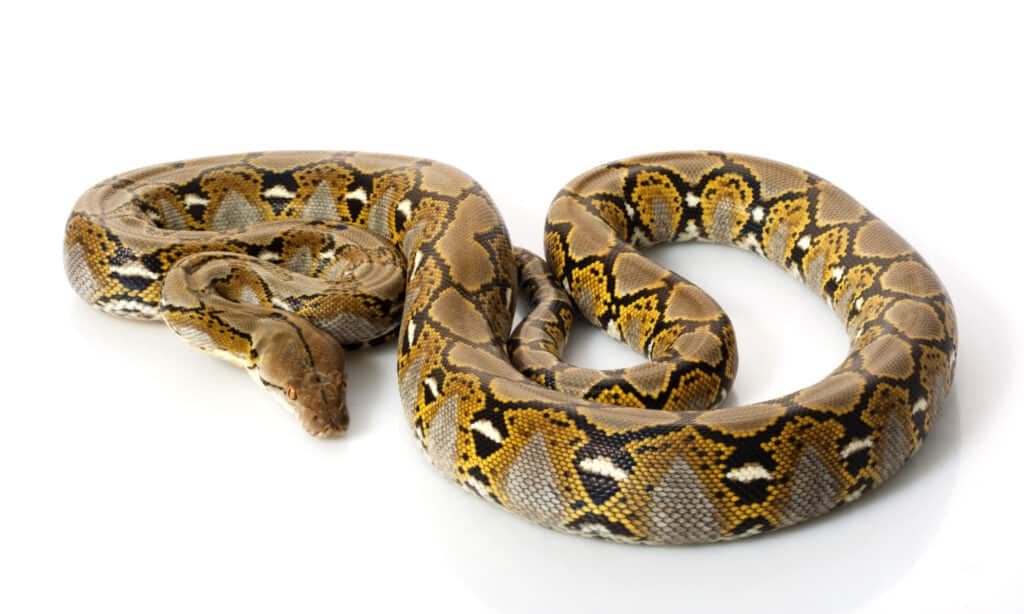
The winner of this epic battle is the massive and formidable reticulated python.
©fivespots/Shutterstock.com
Thank you for reading! Have some feedback for us? Contact the AZ Animals editorial team.

